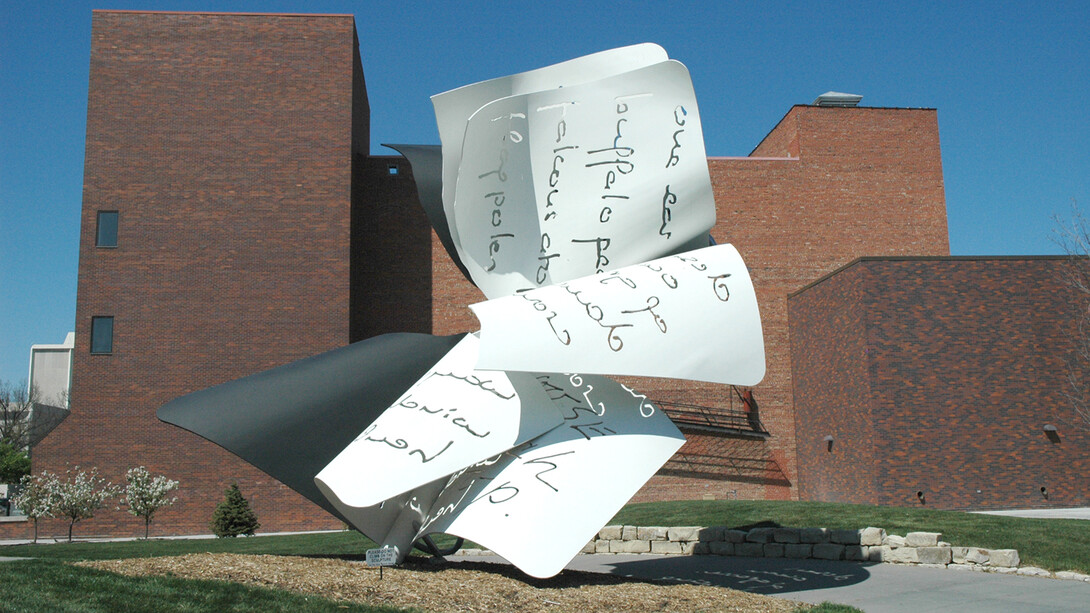
Sheldon Museum of Art is celebrating International Sculpture Day with a tour of its “A Century of Sculpture at Sheldon” exhibition at 2 p.m. April 24.
International Sculpture Day is annual event celebrating and advancing the understanding of sculpture and its contributions to society. The day is organized by the International Sculpture Center and Sculpture Magazine.
In addition to sculpture on display inside the Sheldon, UNL offers more than 30 outdoor sculptures across its campuses. A recently updated map of the sculptures is available online.
For more information on the Sheldon tour, click here.
Here are seven facts about “Torn Notebook,” one of UNL’s most iconic and recognizable outdoor sculptures.
Big artists
Claes Oldenburg and Coosje Van Bruggen, the artists who designed “Torn Notebook,” are known for creating colossal sculptures of everyday objects. The artistic duo is responsible for more than 30 of the large-scale sculptures, including “Spoonbridge and Cherry” at the Walker Art Center in Minneapolis and “Shuttlecocks” at the Nelson Atkins Museum of Art in Kansas City. For a complete list of their giant sculptures, click here.
Scenic inspiration
During the drive from Kansas City to Lincoln, Oldenburg and Van Broogen wrote down their observations. Coosje’s notations were mostly lyrical phrases, such as “falcons atop flagpoles” and “crows on the butte.” Claes wrote primarly the names of things, such as “barbed wire” and “roller skate.” When they returned to their New York studio, the artists realized that a sculpture about the process of collecting observations would be a good fit for a university. The final design of “Torn Notebook” was inspired by Claes’ habit of tearing his spiral-bound pocket notebooks in half.
Big, but do not climb
“Torn Notebook” is in three pieces — a primary notebook structure and two other pages that look to be blowing away in the wind. The primary structure is 22 feet tall and 35 feet long. The sculpture is made of stainless steel, steel and aluminum, all painted with polyurethane enamel. While the structure is strong and anchored deep within the ground, campus visitors are asked not to climb on it to avoid damage to the sculpture or injury to climbers.
Poetic design
The pages of “Torn Notebook” include some of the actual words and phrases written down by the artist during their journey through the Missouri River Valley. One of the upright pages reads, “Wind clouds straws in the sand.” Another reads “barbed wire L-bow.”
Sheldon commission
“Torn Notebook” was commissioned by the Sheldon Museum of Art in March 1995. It was installed on Aug. 20, 1996 and inaugurated on Sept. 6, 1996. It is a part of UNL’s Madden Garden, on the northeast corner of 12th and Q streets, which is the area where City Campus and downtown Lincoln merge.
Fixed up
A renovation in June 2007 removed weather-related damage done to “Torn Notebook” during its first 11 years on campus. The project included the addition of weep holes in the undersides of the sculptures silver spiral. The holes were needed as water was getting into the sculpture, causing damage during through freezing and thawing in winter months. The work also included the welding of two cracks that had developed in the spiral. Read more about the renovation here.
Almost a football?
When word spread in 1993 that Oldenburg was on campus looking for a site to place a monumental sculpture, rumors spread that the design would be of a football. However, Oldenburg never really considered linking the design to Memorial Stadium and Huskers football. “When we go to a site, we always consider the obvious first. In the case of Nebraska, it was almost too obvious, too cliché,” Oldenburg said.








